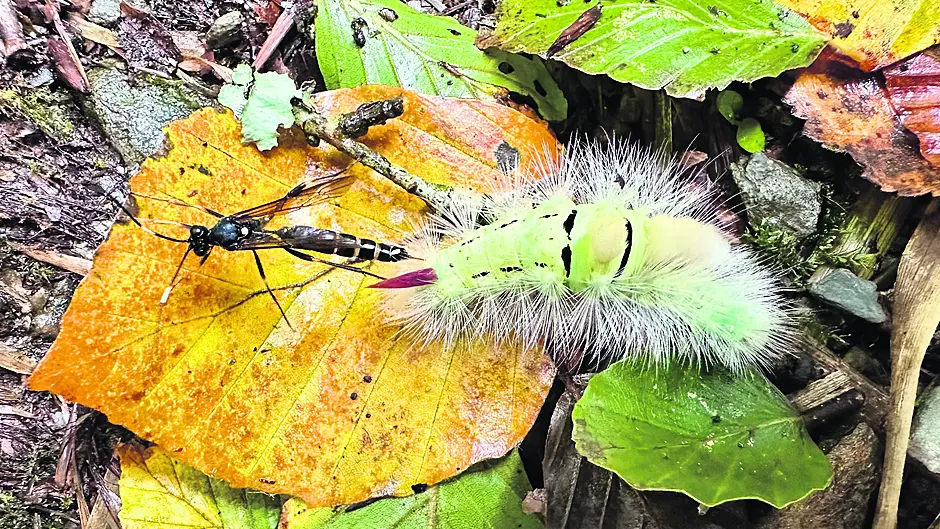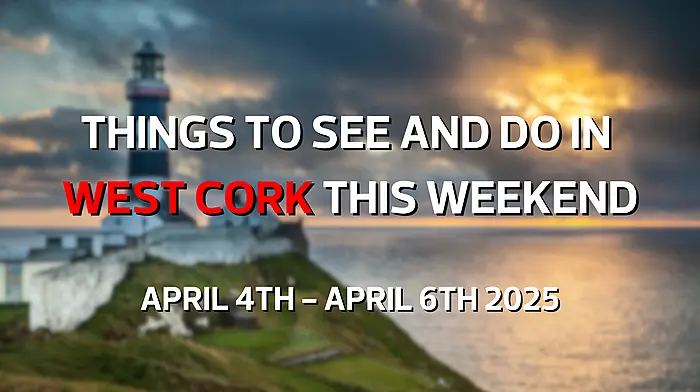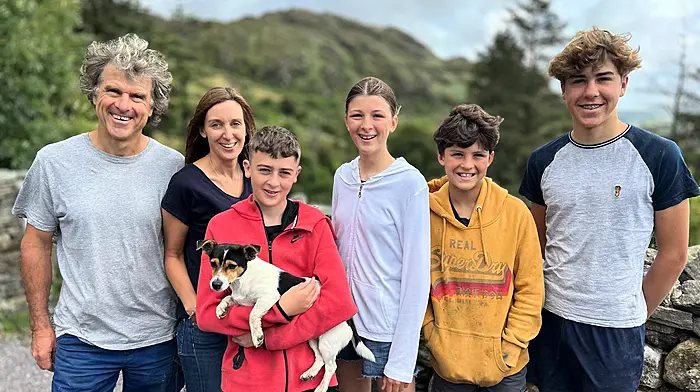HAVING two boys in primary school, I have made it my business to know exactly where I can take them for a ‘run around’ within a 20 km radius of our house.
Exercising this pair of energetic humans is essential, otherwise cabin fever sets in and their pent-up energy puts our home interiors at a high level of risk. Previous occasions involving their invention of indoor teddy bear soccer come easily to mind. In particular, the woodlands in West Cork provide safe off-road spaces for the boys to explore. We often visit the woods at Rineen, Myross, Lough Hyne, Castlefreke, and Inishbeg to name a few.
This motivation to get out and about in all weathers does have plenty of benefits. In between the boys getting some fresh air and burning off energy, we have also managed to spot some truly amazing nature. Even on our most recent trip to Dromillihy Wood, Leap, there was plenty to feed our appetite for our local flora and fauna. Here are just a few observations from our latest woodland wander.
Under attack
One of the most exciting things about nature is that there is always something new to discover. Most often this is something new for us, that we did not know, or that we have not seen before. However, very occasionally it is still possible for members of the public to discover something new to natural science or to find an Irish first.
Last weekend, in Dromillihy, the boys spotted a yellow and green hairy caterpillar crawling speedily across the path in front of us. The little creature was easily recognisable as a pale tussock moth caterpillar; however, the startling thing was that the caterpillar was trailing a parasitic wasp behind them. The wasp was piercing the caterpillar with their ovipositor which is the needle like appendage that parasitic wasps use to inject other unsuspecting creatures, most often caterpillars, with their eggs. The eggs then hatch inside the caterpillar and the resulting larvae feed on the soft insides of the caterpillar until they eventually break through and pupate.
A first for Ireland
Curious to identify the species of parasitic wasp, I posted a photo in an invertebrate identification group on Facebook. This group is called “Insects/invertebrates of Ireland” and has many experts in the various species groups. These experts are extremely helpful in giving their time and knowledge to help people better understand the invertebrates that they find.
An expert on parasitic wasps quickly confirmed the wasp from Leap was Goedartia alboguttata, a parasitoid ichneumonid species that specialises on the pale tussock moth and said that this was a very interesting find. Goedartia alboguttata has been recorded in Ireland before, but there are very few accounts, and these are mostly found in museum collections. There are currently no existing records on the National Biodiversity Data Centre database. They also advised that information about this species is very limited and that it would have been good if I had collected the caterpillar and reared it under observation. It could then have been studied how and when the wasp larvae emerged and I could have submitted a specimen to further confirm the species identification. However, they advised the encounter itself will help to advance the knowledge of this species, with no previously known sighting of Goedartia alboguttata attacking the pale tussock moth caterpillar from anywhere else in the world. It was therefore exciting to record, in West Cork, what is probably the first sighting of this interaction.
Magical mushrooms
In the autumn, woodlands across West Cork host a wonderful array of mushrooms. We have not come across the ‘magic’ kind, but in my opinion, all mushrooms are magical. From puffballs to deceivers, there is what seems like a never-ending multitude of mushroom species to be astonished by. As unrelated as they may seem, to make sense of a mushroom it is best to liken it to a flower or the fruit of a plant. This is because the mushroom is the ‘fruiting body’ of an unseen fungal network, the mycelium, which grows either in the soil or in decaying wood. Fungi do not photosynthesize and instead they get their energy via fungal hyphae, branches of the mycelium, that secrete digestive enzymes into their surroundings to digest dead, and sometimes living, organic materials and organisms.
 Plums and custard mushroom (tricholomopsis rutilans) seen in woodland at Skeagh, Skibbereen.
Plums and custard mushroom (tricholomopsis rutilans) seen in woodland at Skeagh, Skibbereen.The mushroom itself then shoots up from the mycelium and primarily serves to spread reproductive spores so that the fungal growth can spread. There is no scientific difference between a mushroom and a toadstool, it has been traditional to refer to edible fungi as mushrooms and to poisonous ones as toadstools. I do not forage for mushrooms to eat myself because one mistake with an identification can be the difference between life and death. We stick instead to admiring the many shapes and colours of the fungi in our local woods.
 Exploring local woodland, plenty of mushrooms to discover.
Exploring local woodland, plenty of mushrooms to discover.
Autumn leaves
Have you ever wondered what triggers the leaves on deciduous trees to change colour in autumn and to fall to the ground? Seeing the leaves start to change colour and drop last weekend prompted us to reflect on this phenomenon. As temperatures drop and the leaves get less sunlight, production of the green pigment, chlorophyll, stops and it starts to break down. This reveals the orange and yellow colours that the green pigment usually overlies. If conditions are favorable, dry, sunny and above freezing, other pigments such as anthocyanin (red) may be produced.
The process of leaves falling is known as abscission and this is controlled by tree hormones. Levels of auxin, a plant growth hormone, decrease within the leaves in autumn and this triggers the layer of cells that attach the leaf to the tree to change in shape and cause disruption of the attachment. Eventually the leaf falls off due to its own weight or is blown off by the wind.
While it is lovely to see the colourful leaves and to kick and crunch your way through the piles of fallen leaves, these processes do serve a purpose. A tree without photosynthesizing leaves can conserve energy by entering a state of dormancy over winter and leafless trees provide less resistance to winter winds and are less likely to be damaged by the wind.
Even if you do not need to head out to keep children active or to exercise pets, West Cork woodlands in autumn are well worth a visit. You will definitely spot some magical mushrooms and you never know, please do get in touch if you see any caterpillars being attacked by wasps!








